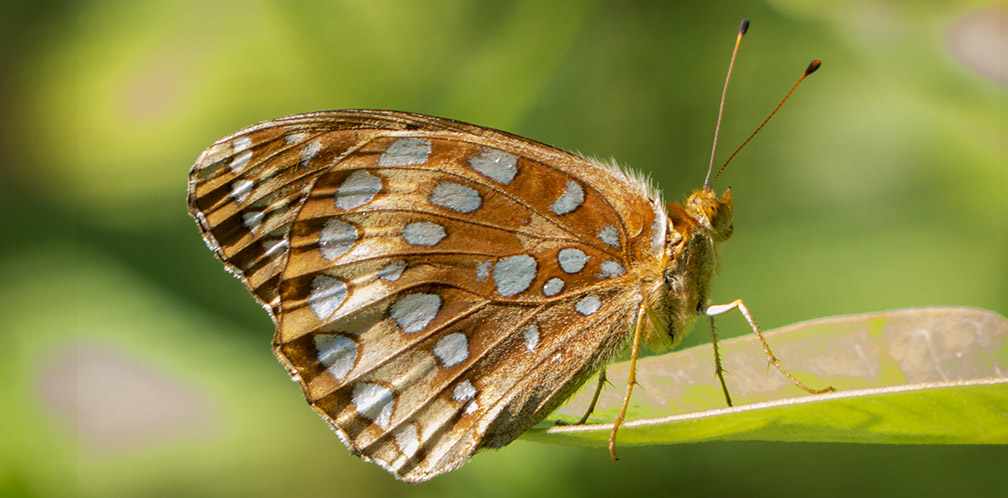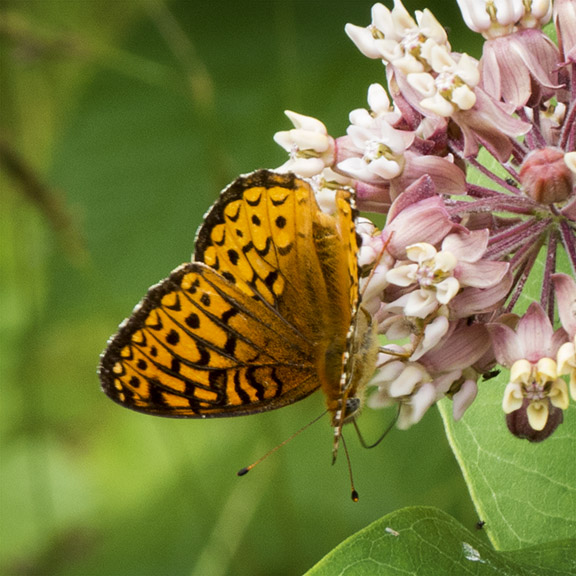Butterflies of the Adirondacks:
Great Spangled Fritillary (Speyeria cybele)

The Great Spangled Fritillary (Speyeria cybele) is a butterfly that may be seen in the Adirondack Mountains of upstate New York in July and August.
Fritillaries belong to the family of brush-footed butterflies.
- The name "fritillary" is derived from the Latin word for "dice box," which is suggested by the checkered pattern of orange and black on the upper surface of the wings. [1]
- The name "spangled" refers to the silvery "spangles" on the undersurface. [2]
- The name "Cybele" is a reference to Cybele, the Anatolian earth goddess.[3] [4]
Great Spangled Fritillary: Identification

From above, the male is tan to orange with black scales on its forewing veins. The female Great Spangled is somewhat larger and darker than the male, [5] usually a yellow brown, darker at the base of the wings. [6] From below, the hind wing has a wide pale submarginal band with large silver spots.[7] In contrast to some other fritillaries, this species lacks a black spot near the base of the fore wing cell. [8]
The Great Spangled Fritillaryis easily confused with both the Aphrodite Fritillary and the Atlantis Fritillary, both of which fly in the Adirondack Park around the same time.
- The Great Spangled Fritillary is somewhat larger than the Aphrodite [9] and lacks the black dot near the lower fore wing base. [10] [11] The tawny submarginal band on the hindwing underside is considerably narrower on the Aphrodite, as compared to the Great Spangled Fritillary. [12]
- One useful identification feature to distinguish the three species is eye color. The Atlantis Fritillary has greyish blue eyes, while both the Great Spangled Fritillary and the Aphrodite Fritillary have brownish or yellow-green eyes. [13] [14]
Great Spangled Fritillary: Life History
Male Great Spangled Fritillaries appear earlier than females to initiate the flight season. [15] Males patrol throughout the day, seeking females. [16] Female Great Spangled butterflies lay their eggs in late summer on or near their violet hosts. [17] The newly-hatched caterpillars overwinter until spring [18] and then crawl to nearby host plants. [19] Host plants include various violet species.[20] [21] [22]
Adults consume the nectar from many species of flowers including milkweed, dogbane, vetch, red clover, and purple coneflower. [23]
Great Spangled Fritillary: Habitat and Range
The habitat of the Great Spangled Fritillary includes forests, woodlands, swamps, marshes, bogs, moist meadows and fields. [24] This butterfly reportedly prefers moist areas in rich soil. [25]
The range of the Great Spangled butterfly includes southern Canada and the northern US (including New York State), south to northern Georgia and west to California and Oregon. [26] [27] It is said to be one of the most conspicuous and common butterflies over meadows and roadsides in parts of the east. [28]
Great Spangled Fritillary: Flight
The flight period and abundance of the Great Spangled Fritillary within the Adirondack Park can only be roughly estimated, based mainly on verified sightings on Butterflies and Moths of North America (BAMONA) and reported observations on iNaturalist.
- The advantage of iNaturalist is that it is a popular citizen science web site that attracts many observers, in part because it covers both plants and animals and in part because the process of submitting an observation is very easy. The disadvantage is that an individual observation can achieve "research-grade" status by being confirmed by the observer and one additional individual, who may or may not have expertise in that particular taxa.
- The advantage of BAMONA is that sightings are verified by regional specialists who are recognized experts. The disadvantage is that there are fewer sighting records for most species, partly because the site covers only butterflies and moths and partly because the process of submitting a sighting is more complicated.
- Both data sets share a common problem of citizen science: reported trends may reflect trends in the number of observers and their willingness to submit reports, not the abundance of the butterfly in question. In addition, the Great Spangled Fritillary is quite similar in appearance to both the Atlantis Fritillary and the Aphrodite Fritillary and can be easily confused with these species if the observer does not have a clear view of the specimen. As a result, the number of recorded sightings may not reflect this species' abundance.
With these caveats in mind, it appears that Great Spangled Fritillaries in the Adirondack region usually fly from about late June to early September, with most sightings in July.
- The Great Spangled Fritillary butterfly was seen in early July 2012 in the Adirondack Mountains south west of Paul Smiths. [29] We generally saw this species in the Paul Smiths VIC Butterfly House mid to late summer. [30] In 2013 and 2014, Great Spangled Fritillaries were observed in the Butterfly House from early July to around mid-August. [31]
- Most of the BAMONA-verified sightings for Great Spangled Fritillaries in the Adirondack Park counties suggest that this species is seen within the Blue Line mainly in July, with a few late June sightings and a few August sightings. [32]
- The pattern of research-grade iNaturalist observations indicates a similar pattern. Great Spangled Fritillaries are most commonly seen in July, although there are some late June and August sightings. [33] There are 65 research-grade observations for Great Spangled Fritillaries in the Adirondack Park. [34] This compares with 37 Adirondack Park research-grade observations for Aphrodite Fritillaries [35] and 195 research-grade observation for Atlantis Fritillaries. [36] The most frequently observed butterfly in the Blue Line is the Monarch, with 581 research-grade observations. [37]
References
- Susan Grimm Hanley. Interpretive Naturalist, Paul Smith's College Native Species Butterfly House. Species Logbooks.
- Butterflies and Moths of North American. Species Profiles. Sighting records:6/28/2012; 8/18/2012; 8/25/2012; 8/26/2012; 7/6/2013; 7/15/2013; 7/22/2013; 7/27/2013; 7/31/2013; 7/5/2014; 7/5/2014; 7/12/2014; 7/12/2014 7/12/2014; 7/12/2014; 7/19/2014; 7/19/2014; 7/26/2014; 8/1/2014; 8/1/2014; 8/1/2014; 8/8/2014; 8/8/2014; 8/8/2014; ;8/9/2014; 8/19/2014; 8/19/2014, 6/29/2015; 7/2/2015; 7/06/2015; 7/13/2015; 7/21/2015; 7/25/2015; 7/29/2015; 7/30/2015; 8/15/2015; 7/18/2016; 9/1/2016; 6/30/2018; 7/15/2018; 7/8/2018; 9/1/2018; 9/07/2018; 6/29/2019; 7/27/2019; 6/25/2020; 7/02/2020; 7/25/2020; 8/9/2020; 7/14/2021; 8/23/2021; 9/17/2021. Retrieved 19 July 2022.
- Government of Canada. Canadian Biodiversity Information Facility. SpeciesBank.
- Massachusetts Butterfly Club. Massachusetts Butterfly Species List. Retrieved 19 July 2022.
- iNaturalist. Species Account. Great Spangled Fritillary. Speyeria cybele. Retrieved 19 July 2022.
- iNaturalist. Adirondack Park Observations. Great Spangled Fritillary. Speyeria cybele. Retrieved 19 July 2022.
- iNaturalist. Adirondack Park Observations. Aphrodite Fritillary. Speyeria aphrodite. Retrieved 19 July 2022.
- iNaturalist. Adirondack Park Observations. Atlantis Fritillary. Speyeria atlantis. Retrieved 19 July 2022.
- iNaturalist. Adirondack Park Observations. Monarch. Danaus plexippus. Retrieved 19 July 2022.
- Iowa State University. Department of Entomology. BugGuide. Retrieved 19 July 2022.
- Ross A. Layberry, Peter W. Hall, and J. Donald Lafontaine. The Butterflies of Canada (University of Toronto Press, 1998), pp. 168-169, Plate 12.
- Maritimes Butterfly Atlas. Atlantis Fritillary. Speyeria atlantis. Retrieved 9 July 2021.
- Maritimes Butterfly Atlas. Aphrodite Fritillary. Speyeria aphrodite. Retrieved 9 July 2021.
- National Audubon Society. Field Guide to Butterflies (New York: Alfred A. Knopf, 1981), pp. 545-546. Retrieved 19 July 2022.
- Montana Field Guides. Aphrodite Fritillary. Speyeria aphrodite. Retrieved 9 July 2021.
- Jim P. Brock and Kenn Kaufman. Kaufman Field Guide to Butterflies of North America (Houghton Mifflin, 2003), pp.158-159.
- Paul A. Opler. A Field Guide to Eastern Butterflies (The Peterson Field Guide Series, Houghton Mifflin Company, 1992,1998), pp. 82-83, 257-258. Retrieved 19 July 2022.
- Jeffrey Glassberg. Butterflies of North America (Michael Friedman Publishing, 2002), pp. 126-127. Retrieved 19 July 2022. Retrieved 19 July 2022.
- James A. Scott. The Butterflies of North America. A Natural History and Field Guide (Stanford University Press, 1986), pp. 325-326. Retrieved 19 July 2022.
- Donald and Lillian Stokes. Stokes Butterfly Book. The Complete Guide to Butterfly Gardening, Identification, and Behavior (Little, Brown and Company, 1991), pp. 76-77.
- Jeffrey Glassberg. Butterflies through Binoculars. The East. A Field Guide to the Butterflies of Eastern North America (Oxford University Press, 1999), pp. 103-104, Plate 28. Retrieved 19 July 2022.
- Paul A. Opler and George O. Krizek. Butterflies East of the Great Plains: An Illustrated Natural History (The Johns Hopkins University Press, 1984), pp. 132-133, Plate 21.
- Rick Cech and Guy Tudor. Butterflies of the East Coast. An Observer's Guide (Princeton University Press, 2005), p. 162-163. Retrieved 19 July 2022.
- David Carter. Butterflies and Moths (Dorling Kindersley, Inc., 1992), p. 131. Retrieved 19 July 2022.
